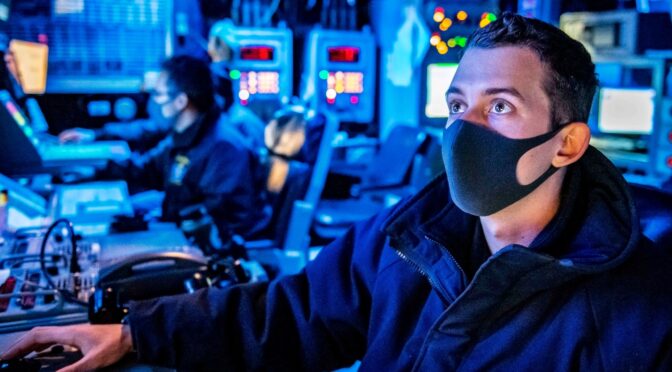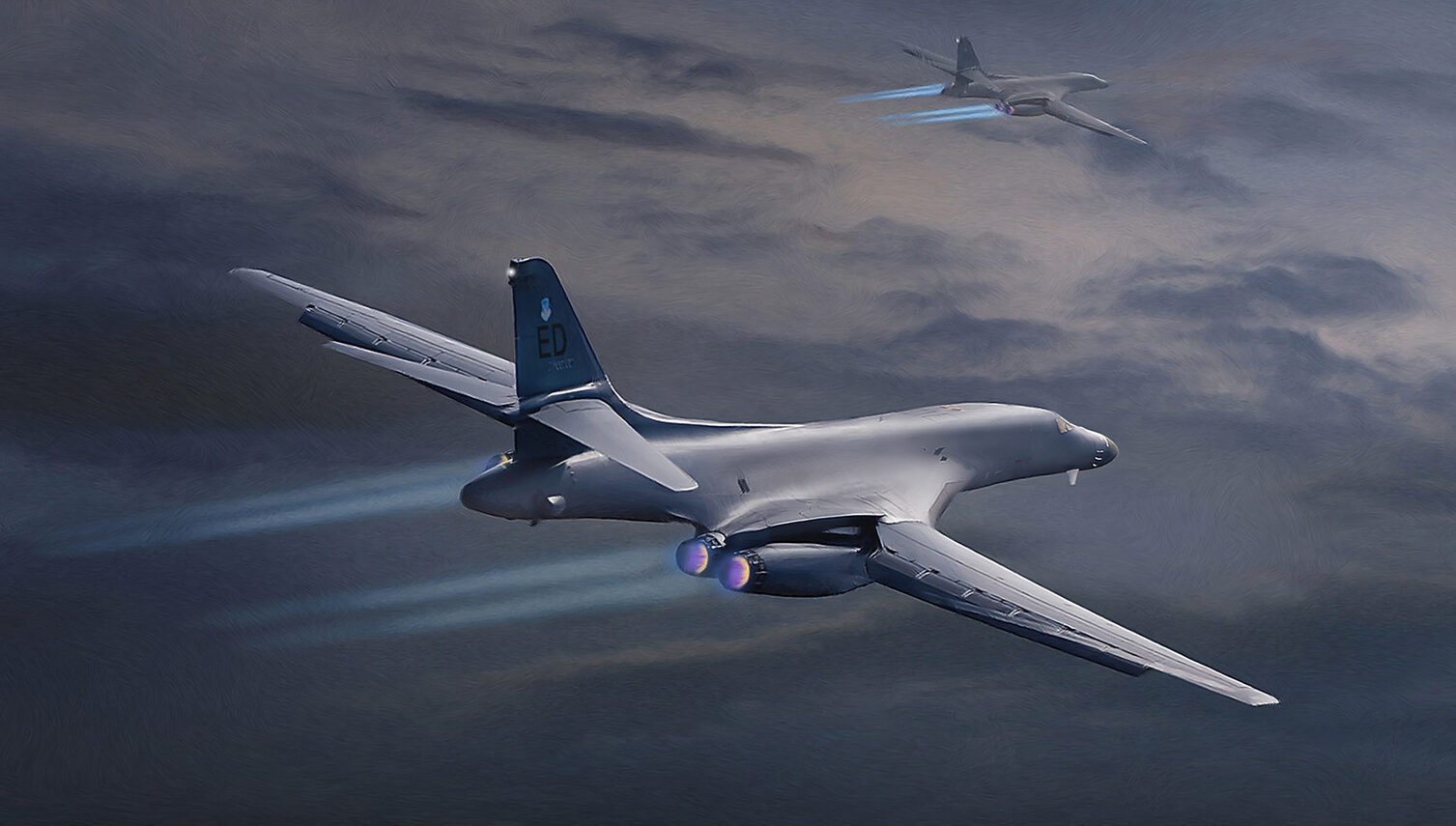By Michael Tiefel and Andrew Orchard
In his book Fleet Tactics and Naval Operations, Capt.(ret) Wayne Hughes states: “At sea the essence of tactical success has been the first application of effective offensive force.”1 Capt. Hughes’ warfighting axiom – applying offensive force first – is the distinct advantage information warfare (IW) intends to deliver, and it is predicated on sound battlespace awareness (BSA). Given the advances in the speed, precision, and destructive power of modern naval weapons, finding and fixing the adversary remains indispensable.
A powerful suite of BSA tools exists now, and they hold the key to making sense of an increasingly complex environment for Carrier Strike Group (CSG) and Expeditionary Strike Group (ESG) IW Teams. Incorporating BSA tool familiarization and training in IW schoolhouses while exercising their use in the Fleet Response Training Program (FRTP) cycle is an opportunity the IW community must seize to maintain an edge over potential adversaries.
Artificial intelligence and machine learning (AI/ML) integration will drive future conflicts. In 2018, the Department of Defense (DoD) published its Artificial Intelligence Strategy and established the Joint Artificial Intelligence Center (JAIC) in recognition of this fact.2 The AI Strategy directs the military to accelerate research, development, and adoption of AI/ML into a range of defense activities. The JAIC, meanwhile, manages the DoD investment in the application of AI/ML in activities ranging from logistics management to BSA. It serves as the executive agent for the military’s adoption of AI Strategy and seeks opportunities to move the military from traditional “Handcrafted Knowledge Systems” towards the development and incorporation of AI/ML.3 JAIC’s efforts portend exciting changes and will fundamentally transform how the Navy approaches the BSA mission.
However, none of these AI/ML efforts have resulted in tools the force can use now. Fortunately, there are BSA tools available to make Information Warfare teams effective in today’s maritime fight and that of the near future until AI/ML capabilities mature. Potential adversaries also recognize the criticality of winning the BSA battle and the possibilities of AI/ML in the long term. To remain ahead of these challengers and prevent them from gaining “the potential for decision by technological surprise,” the US Navy must expand its advantages in understanding the operational environment, and that starts with the effective use of currently available BSA tools.4
The Future Is Now: A Powerful Suite of Tools Exists
There is a pervasive belief both within and outside the Information Warfare community that BSA watch standers cannot successfully compete in a data- saturated world without AI/ML to help them understand the tactical picture. Action officers have spent many hours writing urgent operational needs statements to argue for rapid development and fielding of analytical tools to do the work usually placed on junior officers and Sailors. This panacea AI solution probably will not materialize in the near term, even though the JAIC continues to work to this end. The tools currently available may be the ones with which the next maritime conflict will be fought, and the fact is they work! Information Warfare officers must make an earnest effort to train their Sailors to complement traditional analysis tools with multi-intelligence fusion applications. CSG and ESG Staff Intelligence Officers play a significant role in cultivating a culture within their watch and analysis teams to push the envelope of available BSA capabilities in order to build the most accurate maritime picture from which commanders make tactical decisions even under stressful conditions.
Afloat intelligence teams are now prioritizing training in Intelligence Community-wide tools as a standard operating practice for BSA watches.5 Not only does this train personnel on “buttonology,” but it also ensures watch teams understand the data sources from which they derive information, identify alternative sources if available, and appreciate data that is not available and what that means to their analysis. Officers and Sailors must understand the fundamentals of BSA tools and the sources that feed them; they must know other search mechanisms when missing information and explain their analytical process to other ship watches, aviators performing pre-flight walkthroughs, or even the strike group commander.
Afloat intelligence teams are also employing these BSA tools for analysis across all work centers from the air wing to shipboard cryptology. It is our experience that core BSA tools including the Fusion Analytic Development Effort (FADE) tool suite, Thresher data fusion tool, and Defense Intelligence Agency’s Think, Analyze, Connect (TAC) are integral to understanding the threat and operational situation in today’s dynamic maritime environment.6 Watch standers and analysts more quickly and accurately cross-reference information, build greater confidence in their use of traditional program of record systems, such as generic area limitation environment (GALE), and make higher confidence intelligence assessments through their continued utilization of these and other BSA tools.
How to Make the Connection: Cross-functional Training
Cross-functional training is the natural complement to BSA tools implementation; Sailors require a functional understanding of how each discipline provides value to the organization to use these tools most effectively. This is not a novel concept. Many papers have been written on the need for cross-pollination within intelligence and cryptologic communities to better operationalize information warfare.7 However, there is no better environment to push the boundaries of integration than in SUPPLOT or EXPLOT.
A common understanding of the various intelligence and cryptology specializations enables efficiency both on the watch floor and in the other intelligence work centers. An Intelligence Specialist (IS) with an ELINT background can leverage a Cryptologic Technician Technical’s (CTT) skill to find uncooperative contacts while he or she resourcefully locates cooperative contacts. Similarly, a CTT able to correlate imagery with ELINT can identify a vessel of interest without assistance and allow for more economical use of time for those high demand positions such as the Red Database Manager or the Force Intelligence Watch Assistant.
This cross-functional approach does not demand in-depth expertise, but instead requires a basic, working understanding of the IS and CT disciplines. Watch standers benefit from cross-functional working knowledge that breaks down knowledge silos and enables collaboration using a common language and BSA tool set. A shared background fosters the free flow of analytical ideas by unifying the team. Ultimately, a unified and self-aware team will remain one step ahead, thereby creating a distinctive capability.8 At the Strike Group level, our distinctive capability begins with training personnel on Intelligence fields, data sources, BSA tools, and fleet operations.9 The goal is to familiarize, which precedes, or at least tightly accompanies, analytic skills development.
Watch standing qualification now requires a combination of fundamental and practical lessons to create a cross-functional foundation. The fundamentals portion provides a basic understanding of the “how” behind each facet. Much like Surface Warfare Officers must understand how a warship’s systems acquire and track targets; information warfare professionals need to understand the sources and methods behind the data. Such lessons also concentrate on improving technology literacy and operational knowledge. Both are critical to effectively using advanced analytics and associated technologies during the practical training. The practical segment seeks to build the technical skills an intelligence professional requires to turn data and information into intelligence. The best way to become an intelligence professional is to work through as many practical examples as possible. Initial practical training emphasizes the development of personnel skills, patterns of life, and technology familiarization. Once mastered, practical applications focus on cross-functional communication and team building to meet strike group intelligence demands.
Battlespace Awareness Tool Recommendations
Recommendation 1: Build BSA tools and cross-functional training into routine watch practices. Two years ago, Carrier Strike Group Five (CSG-5) introduced substantive changes to the SUPPLOT training syllabus. We recognized the need for cross-functional training on the various BSA tools currently available. All watch standers, whether they are direct support personnel assigned from a Navy Information Operations Command (NIOC), the USS Ronald Reagan, or Carrier Air Wing 5 complete both common and specialized job qualification requirements (JQR) that includes proficiency in a BSA toolkit (i.e., Thresher, MIST, TAC). At sea, our ability to train personnel relies upon knowledge gained through informal online training, on-the-job training and through active interest by the various IS, CT, and officer users. Additionally, CSG-5 frequently coordinates with CACI, NRO, ONI and the USAF to schedule training opportunities for watch standers as these courses are available.10 We recommend all deploying CSGs/ESGs build BSA tool competency and a cross-functional approach into their watch standing JQRs.
Recommendation 2: Ensure Information Warfare students receive BSA tool training early. The Center for Information Training (CIWT) must integrate modern Battlespace Awareness tools into its curricula across the basic Intelligence Officer, basic Cryptologic Officer, Cryptologic Resources Coordinator (CRC), and various IS, CTT and CTR “A” school training curricula. This aligns with Admiral Gilday’s charge in his NAVPLAN 2021 that the Navy reforms its education programs to win in day-to-day operations and in combat.11 We are confident our Information Warfare schools can find space within the margins of Training Requirements Reviews to incorporate initial training on FADE MIST, A2, Thresher, and TAC. This change will also address a training deficiency in the OPINTEL toolkit identified by LT William Murray in 2019.12 However, training in BSA tools cannot end at the accession level training commands.
Recommendation 3: Reinforce early training with sustained training events during the FRTP. Fleet training commands must begin to integrate follow-on training and OPINTEL tool utilization during all phases of the CSG/ESG work up cycle. For example, some Information Warfare Training Commands must invest in a second iteration of BSA tool training as part of the Supplementary Plot (SUPPLOT) and Expeditionary Plot (EXPLOT) Team Trainer (SETT) events. Fleet training commands, such as our Naval Information Warfare Training Groups, should then put the SETT classroom instruction into practice as part of the Fusion Analysis Team Trainer (FATT) and Afloat Information Warfare Team Trainer (AIWTT). Deploying CSGs and ESGs should have the confidence to explore these tools during Fleet Synthetic Training (FST) and Composite Training Unit Exercise (COMPTUEX) graded events. There remains an important role for NRO, CACI, ONI or USAF training opportunities beyond the introduction to these tools at the basic schools and into the FRTP process. We envision these organizations moving beyond teaching the basic application of these tools to more sophisticated training events that allow for mastery of these capabilities. Furthermore, repetitive training opportunities allow these organizations to refine their curriculums to address basic and advanced training requirements as well as update their tools through fleet feedback.
Recommendation 4: Engage IW WTIs to be our BSA tool experts. Finally, we must ensure our WTIs are well versed in the variety of BSA tools currently at our disposal and able to implement rigorous training programs for our junior officers and Sailors. Several WTI candidates communicated with CSG-5 during our 2020 deployment to discuss thesis topics and request reviews of their final projects. Looking back, we should have pressed them to write projects on the training and application of current BSA tools for deploying naval forces. Naval Information Warfare Development Center (NIWDC) must include robust training in BSA tools as part of their standing WTI curriculum to make our future training officers successful in the fleet. The fleet deserves NIWDC-trained instructors well versed in existing tools and energized to help nurture their use from the tactical level up through the operational level at Maritime Intelligence Operations Centers .
Battlespace Awareness Tools Allow the Navy to Act Decisively First
Potential adversaries will continue to develop the requisite technology and weaponry to amass an effective offensive force. In response, the Navy is introducing new hardware, more demanding pre-deployment training and exploring AI/ML to address these challenges. Information warfare will enable the success of these efforts by maintaining the Navy’s advantage in BSA using existing analytical tools, building commonalities across the IS and CT force to encourage collaboration and communication, and modifying officer and enlisted training syllabi to allow for early and continuous integration of BSA resources. Moreover, broad use of current BSA tools across both intelligence and cryptologic communities and supported by our WTIs engenders feedback from multiple perspectives. This feedback continues to be critical to tool developers as they refine many of these analytical tools even as we move away from handcrafted knowledge systems towards contextual adaptation and beyond.
To achieve battlespace awareness to the satisfaction of any commander is the intelligence community’s highest objective. Intelligence personnel must be best prepared to provide confident analytical assessments of the tactical situation so that commanders and naval forces can make informed tactical decisions with greater confidence and speed than their adversaries. As CAPT Hughes wrote, “winners have out-scouted [battlespace awareness] the enemy in detection, in tracking, and in targeting.”13 A growing appreciation for BSA tools accompanied by a robust training program tailored toward fast recognition and quick integration of all available data ensures information warfare professionals remain at the leading edge of this mission critical requirement to out-scout the adversary, even in the information realm. This will allow the Fleet to be the one “who would attack decisively first.”14
Michael Tiefel is a U.S. Navy intelligence officer and currently serves as the Executive Officer at the Center for Information Warfare Training, Pensacola, FL.
Andrew Orchard is a U.S. Navy intelligence officer and currently the officer in charge of the Joint Reserve Intelligence Center New Orleans.
The authors thank Capt. James Pendergast, USN, commanding officer of the Hopper Information Services Center at the Office of Naval Intelligence, for his review and inputs into the final version of this paper.
The views expressed are those of the authors and do not necessarily reflect the official policy or position of the U.S. Navy, Department of Defense, or the U.S. Government.
Endnotes
1 Hughes, Wayne P. Fleet Tactics and Coastal Combat. Naval Institute Press., 2018, 206.
2 Department of Defense. “SUMMARY OF THE 2018 DEPARTMENT OF DEFENSE ARTIFICIAL INTELLIGENCE STRATEGY: Harnessing AI to Advance Our Security and Prosperity.” https://media.defense.gov/2019/Feb/12/2002088963/-1/-1/1/SUMMARY-OF-DOD-AI-STRATEGY.PDF, 5.
3 Allen, Greg. Understanding AI Technology: A concise, practical, and readable overview of Artificial Intelligence and Machine Learning technology designed for non-technical managers, officers, and executives. Joint Artificial Intelligence Center (JAIC), April 2020, 3.
4 Hughes, 229.
5 Although we reference SUPPLOT throughout this article; our methodology and tools have equal practical application in Expeditionary Plot (EXPLOT) as well.
6 The National Reconnaissance Office maintains a suite of tools under their FADE program that contribute to the BSA toolkit used afloat.
7 Schwille, Michael, et al. “Improving Intelligence Support for Operations in the Information Environment.” RAND Corporation, 2020, doi:10.7249/rb10134.
8 Barney, Jay, and William Hesterly. “Strategic Management and Competitive Advantage.” Competitive Strategy, 2011, doi:10.7551/mitpress/8956.003.000, 149-153.
9 We recognize an appreciation for blue force capabilities is important. In fact, the CSG-5 Battlespace Awareness team works with surface, air, MISR (which resides within the N2 Department) and Information Warfare WTIs on a daily basis to ensure an understanding of blue force tasks and capabilities, allowing the SUPPLOT team to focus on N2’s Intelligence priorities. See Nelson, Christopher, and Eric Peterson. “Naval Intelligence Must Relearn Its Own Navy.” Proceedings, 13 Feb. 2020, www.usni.org/magazines/proceedings/2020/february/naval-intelligence-must-relearn-its-own-navy.
10 Individuals with SIPRNET accounts are welcome to review the SUPPLOT JQR on the CTF-70 Collaboration at Sea (CAS) webpage.
11 Gilday, Michael ADM. “CNO NAVPLAN 2021,” https://media.defense.gov/2021/Jan/11/2002562551/-1/-1/1/CNO%20NAVPLAN%202021%20-%20FINAL.PDF, 6.
12 Murray, William N. “Reimagine Intelligence Officer Training.” Proceedings, 21 Feb. 2019, www.usni.org/magazines/proceedings/2019/january/reimagine-intelligence-officer-training.
13 Hughes, 212.
14 Hughes, 212.
Featured Image: EAST CHINA SEA (July 17, 2020) Lt. Louis Petro, from Weeki Wachee, Fla., stands watch as the tactical action officer in the combat information center aboard the amphibious dock landing ship USS Germantown (LSD 42). (U.S. Navy photo by Mass Communication Specialist 2nd Class Taylor DiMartino)




